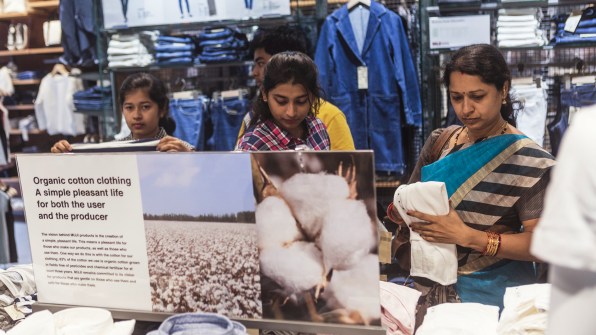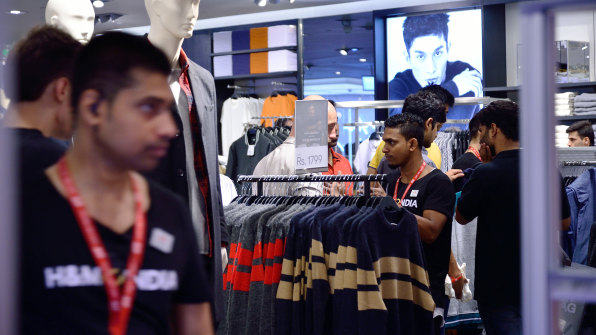Last Thing on My Mind Indian Fashion Brand
Starting a decade ago, in my early twenties, I spent several months every year in Republic of india doing fieldwork for my PhD. As I visited diverse parts of the country, I observed a singled-out shift in the clothing shops that lined the streets in larger cities. Next to stores that sold Indian outfits–such as brightly colored saris, tunics, and a traditional pantsuit called a salwar kameez–you could observe American and European brands, like Levi's and H&M. Many women mixed Indian and Western styles, wearing colorful cotton tunics with jeans, for instance.
Western style brands–from Tommy Hilfiger to Nike to Zara–have recognized the enormous opportunity the Indian market opens upwards, and have been rushing in to woo Indian consumers. Republic of india's economy is expected to grow 8% a yr until 2022, and the Indian centre class is expected to expand at nineteen.iv% a year over the same period, outpacing China, Mexico, and Brazil. According to a report by Business of Fashion and Deloitte, Bharat's fashion market will exist worth $59.3 billion past 2022, making information technology the sixth largest in the world, on par with the U.K. and Germany.
India'southward meteoric growth is dovetailing with a growing awareness of how the dress manufacture's pollution–from plastic waste to carbon emissions–is reaching a breaking point, both in the land and globally.A Nielsen study from eight years ago showed that Indian consumers were already becoming more witting of environmentally friendly style practices, and this sensation is only growing. Groups similar the Worker Diaries, which advocates for the welfare of workers in the region, and Manner Revolution India, which pushes for sustainable and upstanding practices in way, are helping make ethical and sustainable problems more visible. "India has a huge influence on how our fashion is made globally. We are also a huge consumer market," Way Revolution Republic of india writes on its website. It encourages Indian consumers to ask fashion companies to explicate where their clothes come from through social media–and reports it has received responses from over i,000 brands so far.
And fifty-fifty as America pulls out of the Paris Climate Agreement, Bharat has doubled down on its delivery to joining the other nations of the earth in cutting carbon emissions. India'southward Prime Government minister Narendra Modi said it would be a "morally criminal act" for the earth not to confront the looming threat of climate change. Republic of india is the third highest polluter in the earth afterwards China and the United States but is committed to absorbing 2.5 billion to 3 billion tons of CO2 through planting trees, achieving 40% renewable energy by 2030, and reducing the intensity of greenhouse gas emissions based on its GDP by a 3rd below its 2005 levels. According to a contempo United Nations written report, India is on runway to meet the first ii of these goals ahead of this borderline, reflecting the government'due south dedication to averting a climate disaster.
Information technology's of import to notation that on a per capita basis, India is still only the 128th in terms of emissions, and 300 million Indians don't have access to electricity. Every bit its economy grows, more people will move into the middle form and have access to goods that contribute to the globe's pollution, including fashion. As the number of consumers grows, information technology's arguably a disquisitional time to introduce eco-friendly products.
Equally manner'southward biggest European and American brands enter the Indian market place, selling sustainability is non merely the ethical matter to practise–it also makes good business organisation sense. This is role of the reason that global giants are pitching themselves to Indians equally eco-friendly brands. At the same time, equally they rapidly expand, it'southward go clear that to truly tackle the looming threat of climate change (to which the fashion industry contributes mightily), brands need to rethink non only what they are selling customers, but besides how much.

What Big Brands Are Doing At present
The American denim brand Levi's was one of the primeval American fashion labels to enter the Indian marketplace in 1995. The brand has been working to lower its ecology footprint globally, by reducing carbon emissions and using lasers to finish jeans instead of chemicals. Sanjeev Mohanty, Levi's managing manager for South asia, the Center Eastward and N Africa, says that Indian consumers are aware of the importance of such sustainable practices and are more than probable to shop from brands that make wearing apparel ethically.
"As far back as 2011 (when the Nielsen study was conducted), the Indian consumer was already more interested in free energy efficiency in manufacturing, and related practices such every bit the utilize of recyclable packaging," he tells me over e-mail. In its stores Levi'south broadcasts messaging well-nigh its sustainability goals, similar its program to reduce carbon emissions across its offices, retail stores, and distribution network past 40% and employ 100% renewable sources in its own facilities by 2025, or its new technique for finishing jeans that requires less water–which it fabricated information technology open source, in the hopes of saving 50 billion liters of water by 2020. Those goals prove up in Levi's products, too: All Levi'due south and Docker's products have a tag that says "Wash less, wash in cold, line dry, and donate when no longer needed."
H&M, a Swedish brand, is a far newer player in the Indian market. In 2015, information technology opened its first shop in New Delhi, just now has more 40 stores throughout India. It's not only in big cities, where wealthier, more globalized consumers live. It is also in smaller cities, and targets lower-middle class Indians by offering clothes at prices that are affordable to them.
H&M is working to introduce the concept of fast mode in India–merely it's making the case that inexpensive, on-trend clothes can exist made ethically and sustainably. The company says it is working to utilise entirely recycled or sustainably sourced materials by 2030, and totally get-go its carbon footprint by 2040. Part of this approach is to respond to customer demand and sell more products to eco-conscious Indians.
For instance, India is one of the largest producers of cotton fiber in the globe, and many Indian consumers will be familiar with the horrific stories of unabridged villages in the Indian countryside being poisoned past the chemicals used in the cotton-growing procedure. By 2020, H&One thousand aims to source all its cotton wool sustainably–which it defines as using organic cotton, recycled cotton fiber, or cotton fiber certified by the Ameliorate Cotton fiber Initiative, which helps farmers grow cotton in a way that reduces ecology stress.
Like Levi'southward, H&Yard uses its tags to stress its efforts. "When Indian consumers come across green tags on garments (which explicate how eco-friendly they are), they are starting to understand what this means, and thinking, 'Oh this could be good for me,'" says Elin Astrom, H&M India's sustainability manager. "Talk about sustainability and round manner has gained a lot more attention here over the past few years."
The scientific discipline of material recycling is still in its infancy. Organizations–including the H&M Foundation–are working to develop technologies that will be able to split the many fibers that are used in fabric blends. But H&Yard is already working to collect clothes from customers, which are either given to people who will use them or taken autonomously to exist recycled. In 2017, the company collected 17,771 tons of textiles. Information technology has recycling bins ready at all twoscore Indian stores, and Dhatri Bhatt, H&M India's head of communications, says they take been popular with customers. "We've been pretty encouraged by this response," she says. "Customers across the country take been bringing their old garments to recycle them."

Large problems need radical solutions
Yet the industry'southward fatal flaw is that it is congenital on a business concern model of selling more and more clothes to customers faster and faster. According to data from the Ellen MacArthur Foundation, which helps companies and governments transition to a circular economy, the number of times an article of clothing is worn before it gets chucked out has declined by 36% since 2000, with many consumers discarding garments after just seven to ten wears. And in that aforementioned catamenia, the number of units of clothes sold annually has doubled from 50 billion units to 100 billion units. "The reason nosotros see so much waste product happening is because we're producing more and more, and wearing the clothes less and less," says Francois Souchet, a project managing director at the Foundation.
Rather than selling more than clothes that are marginally more than sustainably made, a truly world-irresolute solution would exist to encourage consumers to buy fewer, more durable products. This may seem radical, but we've seen it piece of work for brands like Patagonia, which mends customer's well-worn garments to extend their life, and Eileen Fisher, which eschews way trends to encourage customers to wear the aforementioned outfits season after flavour. While these brands oasis't grown every bit fast every bit their more popular fast fashion counterparts, they are both successful, profitable businesses. A more radical approach to sustainability, both in India, and around the world, is for fashion brands to brand durable products in classic styles.
Every bit they expand into India, global giants have a chance to rewrite the volume on fast manner. What would happen if these brands sold Indian heart class consumers a fundamentally different vision of manner than the i they've sold elsewhere in the globe? What if instead of idealizing newness, they instead focused on quality, immovability, and classic looks that never go out of mode? That would exist a much more constructive approach to sustainability than a simple recycling bin.
0 Response to "Last Thing on My Mind Indian Fashion Brand"
Post a Comment